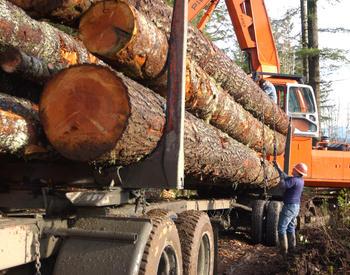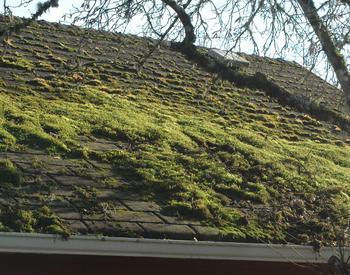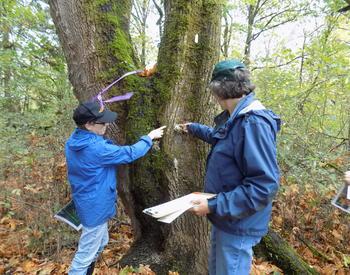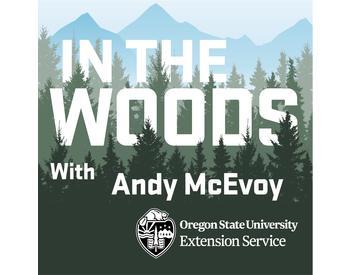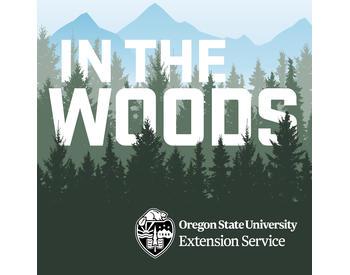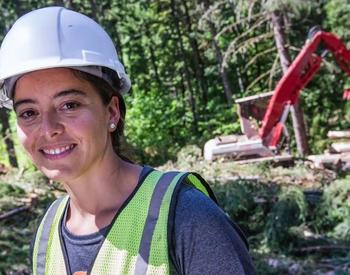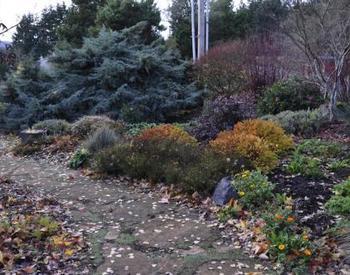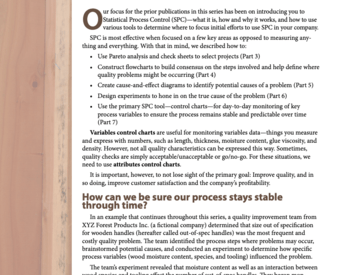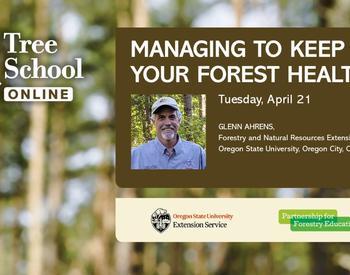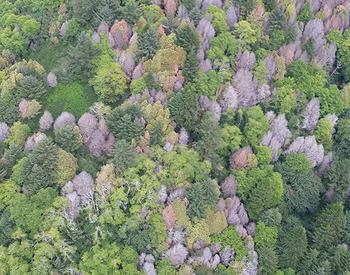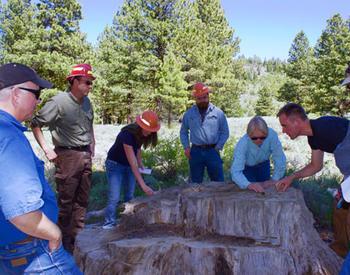Transcript
From the Oregon State University's extension service, you are listening to In The Woods with the forestry and natural resources program. This podcast aims to show the voices of researchers, land managers, and members of the public interested in telling the story of how woodlands provide more than just trees, they provide interconnectedness that is essential to your daily life. Stick around to discover a new topic related to forests on each episode. Hello everyone and welcome back to In The Woods podcast presented by the forestry natural resource extension program at Oregon State University. I am your host Jacob Putney, assistant professor of practice, and extension agent in the college of forestry. This month's episode is going to be an introduction to the Oregon forest products sector. We are joined today by Scott Leavengood, Director of the Oregon Wood Innovation Center at Oregon State University. Welcome Scott, thank you for joining us today. Yeah, thanks Jake, pleasure to be here. So, before we dive into forest products uh do you want to tell us a little bit about yourself and maybe talk about the wood innovation center? Sure, yeah, so uh I've been with OSU extension service since 1994. I've had a couple of um positions with OSU county office positions where I work with the wood products industry in southern Oregon and then up in the Portland metro area. The wood innovation center here is about 15 years old now and uh my title is Director of the Oregon Wood Innovation Center and using more extension type language though I'm a wood products extension specialist. So, my job is really providing technical assistance to the wood products companies around the state. And the wood innovation center itself is really focused on helping companies uh develop new products, solve performance challenges with existing products, and and and even helping the the individual uh the general public if you will understand um how wood products perform in service and things like that.
Well it's great to have you here and it's uh great to have you as colleague in the extension as well, so. Let's go ahead and get started here so um I think we've all seen log trucks heading down the highways in Oregon, um, but have you ever wondered where those trucks and what happens to all those logs? So, what does happen to all those logs? That's a pretty common sight in Oregon for sure and I can tell you having lived in several other states it's not that common in my experience to see trucks with 40 foot long logs rolling down the road, but to answer your question here the wood products industry is broadly categorized into primary, secondary, and reconstituted products manufacturers. And, so, to put it really simply the primary mills are the ones that buy the logs and so primary mills include sawmills that produce lumber, veneer mills that of course they peel the logs to produce thin sheets of wood that are called veneer, and then some of these veneer mills also produce plywood as well as laminated veneer lumber. And then these logs are also going to other mills the other primary mills include utility pole companies as well as log home manufacturers. So, what about log exports? That's often been a hot topic and a controversial one at times as well.
Yes, a small share of the logs from private lands is exported. Uh, the latest data I've seen was that about seven percent of the total harvest in Oregon was exported. So, then what are the major products we make here in Oregon? About two-thirds of the total log volume in the state goes to either lumber or plywood. In fact, Oregon has long led the nation in the production of these products more structural lumber and structural panels are produced in Oregon than in any other state. And what about uh our tree species? Which species are most commonly used? Or I guess um desired in the woods products industry? Well there's a pretty short list of tree species that are commonly used in the state, and really well over 90 percent of the total volume used in Oregon are softwood species. And among the softwoods, Douglas fir leads the pack it represents something like 70 percent of the total harvest. Next, is Western hemlock combined with the so-called True fir species, species like White fir and Grand fir, and so you may have seen lumber stamped "Hem-fir" on it. A Hem-fir is not a species it's it's actually a combination of Western hemlock and these True fir species. So, Douglas fir and Hem-fir are the primary species that are used for structural lumber and plywood. Pine species such as Ponderosa, Lodgepole and Sugar pine these are these are all sawn in the state as well and they're used in products like doors and windows. I notice that you didn't mention any hardwood species on that list. Do we not grow and process hardwoods in Oregon? There is a hardwood industry in Oregon, um, that's pretty it's still pretty small particularly compared to the softwood industry and the major hardwood species by far is Red alder, Bigleaf maple also sometimes called Pacific Coast maple is a distant second, and alder and maple are used for things like cabinets, furniture, frames for upholstered furniture, pallets etc. Shifting gears a little bit um let's talk about processing these logs. Um, I've heard that only about a half, or maybe slightly more, of a log actually gets made into products. That sounds like a lot of the log is wasted. Is that true? Yeah, right, well that does depend on the final product, but, yes, actually it is true that only a little over half of a log can be converted into lumber. Uh the fraction of a log converted into veneer is a bit higher and for utility poles there's very little waste since they usually just remove the bark and maybe a little of the wood to create a good cylinder. But I think it's important here to recognize that while only about half of a log is converted into lumber, that doesn't mean that the rest goes to waste. In fact, nearly 100 percent of a log is converted into usable products of some kind. So, let's circle back to other products in a couple minutes, but, um, first, can you help us understand why with all the technology available today why can't we do better than that uh 50 percent? Why is it that we're only able to convert about half a log into lumber? You know when people get a chance to visit a modern sawmill they're often amazed to see the level of technology being used. These mills use high-tech scanning and optimization systems to scan logs to determine the precise shape of the log and then software will quickly determine the optimal sawing pattern to obtain lumber from every log. So, the fact is modern sawmills are highly automated and very efficient enterprises, but you know to get to your question here waste really is inevitable due to a number of factors. I mean first there's simply the general idea that saw mills essentially turn circles into rectangles. And you can envision this with something like a round pie plate and then try to see how many two by four or two by six inch rectangles you can fit inside that circle again just due to basic geometry waste is inevitable. And geometry also comes into play with respect to taper in logs. The butt end or the stump end of a log is generally larger in diameter than the top. So, that just naturally leads to some waste too. Right, right okay that makes sense so it's really just a geometry issue, um, but what about other limitations on increasing efficiency in saw mills? Yeah, there are a few other things to keep in mind particularly for the structural number from softwood species which again is is really the dominant sector in Oregon. The structural lumber these products are sold in standard lengths, standard widths, and thicknesses. So, for example, an eight foot two by four or a ten foot two by twelve, so, for example, if you have a seven inch diameter log the industry doesn't use two by sevens. So, a mill would cut two by sixes from such a log and then and then chip up the rest. And the same goes for the length a log that's nine and a half feet long would likely be trimmed back to eight feet since the industry uses primarily even lengths: eight feet, ten feet, twelve feet etc. And of course there's sawdust, the material that's lost due to the saw blades. And also when lumber is surfaced smooth in a planer, some material is removed in the form of planer shavings. You know and lastly the one area of material loss that I think most people don't think about is shrinkage. Lumber and other wood products they shrink quite a bit from when they're freshly sawn to when they're dried. So, we actually lose a bit simply due to the shrinkage. And here's a good example for green or in other words wet veneer it might go into the dryer 54 inches wide and shrink a full four inches as it dries and that's not it's not a trivial loss. I didn't even think about shrinkage either. I didn't realize, four inches, that seems like a lot, wow. So, I guess we really don't think about some of those areas where you know waste is unavoidable, but, um, however, you said that nearly 100 percent of that log still gets used so what are these other products then? Well to start with sawmills as an example the first step at a sawmill is to remove the bark. And the big use for bark of course is mulch and Oregon another really big use for bark is as a growing medium for the container crops in the nursery industry. And you may have heard the term hog fuel before. Hog fuel it's a mixture of bark and wood it's produced in a machine called a hammer hog that essentially pummels large chunks of wood and bark into smaller pieces and hog fuel is often burned at mills to produce steam for drying lumber, and the steam is often commonly used to turn a turbine to generate renewable energy. What about uh paper?Can bark or hog fuel be used for paper as well? No, definitely not. In fact, paper mills work very hard to eliminate bark or to simply ensure that what they purchase doesn't have any bark in it. Bark creates little dark dots on paper and it's pretty weak too so your paper grocery sack wouldn't hold up very well if it had a lot of bark in it. So, yeah, so again paper mills really try to avoid bark. Then what about the other residues or byproducts? Um, so, what happens to the sawdust for example? Literally the big uses for sawdust are for fuel pellets like for pellet stoves and particle board. And starting with the fuel pellets, they're simply made from sawdust that's pressed together under really high pressure. The pressure generates heat that results in the sawdust binding together naturally, no adhesives used. Particle board mills do use adhesive, though, and they uh they spray adhesive on the the uh sawdust and press it together and these mills use planer shavings and some of the larger residues as well to make particle board which often goes into furniture or say under the formica under your countertop for example. So, I mentioned the bark and the sawdust, but what about the larger pieces? You know, turning that circle into a rectangle. Right, yeah, larger byproducts in a sawmill like the little half moon shaped slabs from the outside diameter of the log. Those are usually sent to a chipper and again when they're free of bark chips are really the primary raw material used by paper mills. Chips are also used to produce medium density fiberboard which commonly called MDF, and, of course, the chips are used on playgrounds and hiking paths as well. Lastly, I should mention that chips, as well as planer shavings, are commonly used as animal bedding. Again, though, the main idea here is that very nearly 100 percent of a log is converted into usable products it's just not possible to convert it all into lumber or veneer. So, going back to paper now, do we grow trees to make paper in Oregon? Uh, no, we really don't. Though, that is common in the southeast and the midwest regions of the U.S. they have so-called pulpwood plantations of species like southern pines and aspen for example that grow really rapidly, and these trees are harvested at a pretty young age they're chipped uh whole tree chipped and converted into pulp, then paper. But in the pacific northwest pulp and paper are primarily produced from mill residues and recycled fiber. However, we do use some whole trees for pulp. For example, logs that are damaged in some way or that have a lot of decay in them, these low-grade logs may be sent directly to the chipper rather than being sawn into lumber and some of our hardwood species that currently lack a viable market are also chipped uh to be used for pulp. Let's um let's move forward and talk about the future a little bit. Um, you know, we introduced the wood innovation center which you're the director of, um, what sort of innovations do you see occurring in the industry? Well with respect to new products, the big new product that's getting so much attention is cross-laminated timber, or CLT for short, and some other so-called mass timber products like mass plywood panels. I've heard CLT described as plywood on steroids it's uh essentially lumber glued together with the grain and alternating layers at 90 degrees to the adjacent layer, again just like plywood just with larger pieces. CLT is produced in large panels and it's used to produce structures some up to 18 or more stories tall, in fact, there's a dormitory at the University of British Columbia that's 18 stories tall made out of wood. Now, there's a lot of research happening right now to explore making CLT from a variety of wood species different types of connections uh earthquake and fire performance testing and durability to fungi etc. And I'd say the other really big area of new product innovation in wood products is related to wood modification. This involves using heat and or chemicals to essentially alter the chemistry of wood so that it's more durable, harder, stronger etc. There's not a lot of that going on in Oregon right now but I think it's only a matter of time before we'll see some companies producing products like thermally modified timber in Oregon for example. I haven't actually got a chance to visit it yet, but the new forestry building in Oregon State Community Hall is made out of uh CLT correct? Yeah, that's right. In fact, we have two new buildings here uh the Peavy Forest Science Center where the old Peavy was was uh taken down and the new the new uh Peavy Forest Science Center is made out of glulam beams which is an old product but then cross laminated timber panels as well. And then the A.A. Red Emerson Advanced Wood Products Lab which is just southwest of the Peavy Forest Science Center, that's made out of glulam beams and columns as well but also mass plywood panels so we have a couple of mass timber buildings here in the college of forestry now that are just a little over a year old. And did a majority of the wood for those buildings did that come from Oregon or around the pacific northwest? Yeah, it did indeed. Uh, in fact, it's uh Freres Lumber is the the only producer of mass plywood panels. It's a product that they've they've developed and so they've they've produced the material for um uh the Emerson uh wood pro advanced wood products lab and then uh I believe it was D R Johnson uh in Riddle, Oregon that produced the Douglas fir uh cross limited timber panels for from the Peavy Forest Science Center. Yeah, I'm really excited to come check that out next time I make it over into Corvallis it's been a long time coming it's really really exciting to see that all together now that it's finished. Um, so you mentioned earlier some of the other technology used in the industry, so maybe we can kind of wrap this up um start to wrap this up and talk about uh what sort of technologies are being used in mills now and you know what does the future look like. Oh yeah, as I mentioned before people that visit sawmills and other wood products processing facilities are often surprised to see the level of technology being used in the industry now. For example, here in Corvallis where OSU is based, there's a firm that that uses scanning technology like lasers and cameras to identify things like knots and decay and wood, and then they use artificial intelligence to automatically assign a grade to the lumber. And that same company is part of a company that uses CT scanners, like used in the medical field, to scan logs to identify internal characteristics of the logs as well and so that kind of detailed information in the log shape, where the knots are, if there's decay etc. again that kind of information really helps mills to ensure they get the maximum amount of lumber and veneer out of every log. You know it's really amazing it's how much goes into the wood products industry and how much technology is used um we might have to have you on here again and talk about some of these new products being developed. I've done a couple of mill tours um when I was in undergraduate college and it's just amazing is how fast those two by fours can move through some of those facilities. Um, well, you know thank you so much for joining us today Scott, um, to kind of slowly start to wrap up here why don't we move into what we're calling our lightning round where we you know ask each of our guests a couple questions.
And so the first one here is what is your favorite tree? Well my favorite tree, I worked with OSU like I said uh over 25 years now a lot of my my first part of my uh career was spent in Klamath county and I worked a lot with Western juniper there and I'm still working with Western juniper now all these years later and so I've gained a lot of respect for that uh scruffy little tree out in eastern and central Oregon uh it's a it's a tough little tree it grows right out of rocks in some places it can shut down and go dormant uh when there's no water and then turn it on again not a lot of trees seem to be able to do that and so it's aromatic it's naturally durable, again, so, yeah, I'd have to I'd have to say juniper is on the top of my list. No kidding, I think a few folks in eastern Oregon may not agree with you on that. No, it is a very resilient tree I'll have to give you that. Uh, so the next question here is you know what is the most interesting thing you bring with you in the field? Whether in your cruiser vest or field kit? Most interesting thing I bring with me in the field? This might be interesting it might be a little bit of pressure on being with products guy on this one. Yeah, so I'd say for me the field may be a little different than the rest of my co-workers here in forestry extension the field for me is often a visit to a sawmill. And so more and more lately I am bringing in this little automated system for measuring size on lumber for example. So, if we're doing quality control, lumber size control I've got a handy little device here comes out of Vancouver B.C. that put your digital calipers on the lumber push a button on it and it reads into your little handheld tablet and that can give you an instant information on how your saws are performing in the mills, so what kind of deviation you have from end to end and edge to edge and if some maintenance needs to be done so um and and frankly that's that's fairly low tech most of the mills have automated systems with lasers that do that mine I just carry this little portable one with me is all. Uh it sounds actually really interesting I have to check that out one of these days. Uh, so, the last question here is um you know what resources would you recommend for our listeners if they're learning more about the wood innovation center? Or the wood products sector here in Oregon? Or any of the wood products or things that we um develop in our mills all throughout the state? Yeah, well of course I'm putting a plug here for the wood innovation center's website that's owic.oregonstate.edu and we've got quite a bit of information there. I'll say that again owic.oregonstate.edu. Another thing that the wood innovation center at OSU maintains is the Oregon Forest Industry Directory and uh I won't go through the trouble I guess of reading out that that address but um so that's a that's an online directory of all the firms in Oregon, the sawmills, includes landowners, small mill operators, large mill operators, furniture makers, service providers, logging contractors, foresters, things like that. And I always always tell people in fact uh we have a uh you know bachelor's, master's, phd program here in wood science uh called renewable materials for our undergrads and wood science for our graduate students, but um I tell them the the USDA Wood Handbook is really the critical resource to keep at your fingertips as far as understanding different properties of wood. I mean it really goes through everything you ever wanted to know about wood and more in one handy manual and it's online so if you looked up the USDA Wood Handbook: Wood as an Engineering Material, you'll find a pdf version online. Okay, great, yeah we'll make sure and get those resources on our website too. So, thank you again for joining us today Scott it's been great um so as you're listening today if any questions came up or you'd like to hear more about the forest products sector in Oregon you know drop us a comment or send us a message on our website at blogs.oregonstate.edu/inthewoodspodcast. This concludes this month's episode and we will see you all next month bye everyone.
Thanks so much for listening, show notes with links mentioned on each episode are available on our website blogs.oregonstate.edu/inthewoodspodcast. We'd love to hear from you, visit the tell us what you think tab on our website to leave us a comment, suggest a guest or topic, or ask a question that can be featured in a future episode. And also, give us your feedback by filling out our survey. In the woods is produced by Lauren Grand, Carrie Berger, Jacob Putney, Stephenen Fitzgerald, and Jason O'Brien who are all members of the Oregon State University Forestry and Natural Resources Extension Team. This podcast is made possible by funding from the oregon forest resources institute. Music for In The Woods Podcast was composed by Jeffrey Hino and graphic design was created by Christina Friehoff. We hope you enjoyed the episode and we can't wait to talk to you again next month. Until then, what's in your woods?
you
In this episode, Jacob Putney discusses multiple interesting topics regarding forest products manufacturing with Scott Leavengood.

